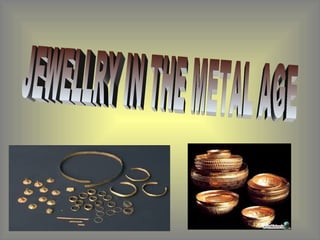
Powerpoints sociales
- 2. Hi class. We are Rubén, Marcos, Rodrigo and Juan and we are going to show you our proyect of social sciences that is about “Jewellery in the Metal Age”
- 5. - Copper was the first metal known. It is low hardness and was used to make ornaments. Example: necklaces, bracelets, rings, earrings, cups, plates, vases
- 6. - Bronze is an alloy of copper and tin and is harder and stronger than copper. Several villages in the eastern Mediterranean discovered the metallurgy and progressed rapidly. With the bronze they manufactured agricultural tools such as plows and sickles; military weapons such as swords, like swords, spears and shields; and household utensils such as jars, bowls and cups.
- 7. - Iron is found somewhere near the Black Sea instead. It is harder and more durable than bronze and was a great superiority in the manufacture of objects. The instruments made of iron were very different: axes, knives, clippers, tweezers, hoes, scythes, sickles, grates for plows, chisels, hammers, compasses, scissors, nail files, razors, harnesses carriage
- 9. FORMS OF WORKING WITH THE METALS Copper is a malleable, weak, soft and of little use for the manufacture of tools and practical metal utensils. With it especially ornaments (beads, bracelets, rings, headbands and pins), which served as luxury items or social prestige for those who take them away were manufactured. However, also found arrows, daggers and axes. Perhaps only the axes may have purposes related to work or combat, although there are serious doubts about its practical utility, given the low strength thereof. Stone axes were still stronger than them. Therefore, the use of metal was still minority and most tools were still stone, hence the Copper Age also be called Chalcolithic(Greek: tracing “copper” and lithos “stone”)
- 10. Bronze alloy is a mixture of nine parts or copper and tin; This combination produces a new metal, much harder than the two components, and easier to melt and work than copper. It is very possible that some other metal is added, such as antimony, because they got an elastic and flexible bronze, that could work in hot. The first of bronze imitates the stone, and thus the first metal axes, had the same triangular handle and lacked such as stone. Fundamentally bronze weapons and utensils were manufactured luxury. Among the weapons, the sword, to be an element that characterize the warlike character of this stage appears. Besides who carries a sword is distinguished socially, belongs to a different from the simple peasants social group. He is a warrior or a boss. Other weapons are daggers, daggers, breastplates, helmets, spearheads and shields.
- 11. Iron is used to make all kinds of tools for the field and to improve working and living conditions of the people Since ancient times it was known in certain places (3000 a. C. in Egypt and Mesopotamia) the use of meteoric iron unprocessed to make small objects. However, the manufacture of iron objects requires some knowledge and a completely different from the bronze technology. While humans of this era could smelt copper and tin, not getting smelt iron at temperatures of copper, and when I tried got a hard mass and weak implementation report. By not getting the right cast iron, iron had to work through ovens, whose fires were rekindled with bellows and forge objects was done by hammering, after successive applications to fire and water to get the correct hardening and tempering . Under iron metallurgy emerged a new craft and some new useful: tongs and hammer blacksmith. The new iron technology therefore required work red hot, and everything was a secret. The first to learn this secret were the Hittites, inhabitants of the central Anatolian peninsula (modern Turkey), who jealously guarded for many years. The Hittite empire would fall around 1200 a. C. and from this date the new iron technology began to spread elsewhere.
- 13. It is located in Ibeas de Juarros, Burgos. It have 900.000 years old. Declarated a World Heritage site in the year 2.000. • ATAPUERCA
- 14. Aliseda’s treasure.VII-VI B.C. Aliseda is located in Cáceres, Extremadura. Now a days you can find it in the “Museo de Arqueología de Madrid”. They found jewllery made of gold, silver, bronze and gemstone. They are from the Bronze age in the Tartessos civilisation.
- 16. In the Metal Age the most common materials were the copper, the iron, the bronze and the tin, but the tin was only used to made alloys like bronze (that is made of copper and tin. Also the metals were extracted from a piece of rock called ore.
- 17. Thanks to the copper, metallurgy was invented and also minery, agriculture and ganadery developed so much. Bronce was discovered in the actual Armenia and during this period Megalithic constructions started to generalize. The Aegean Sea was an intense area of trade The iron was principally the metal used to made tools and weapons because of his strength. There was a lot of changes in agriculture, religious beliefs and artistic stiles.